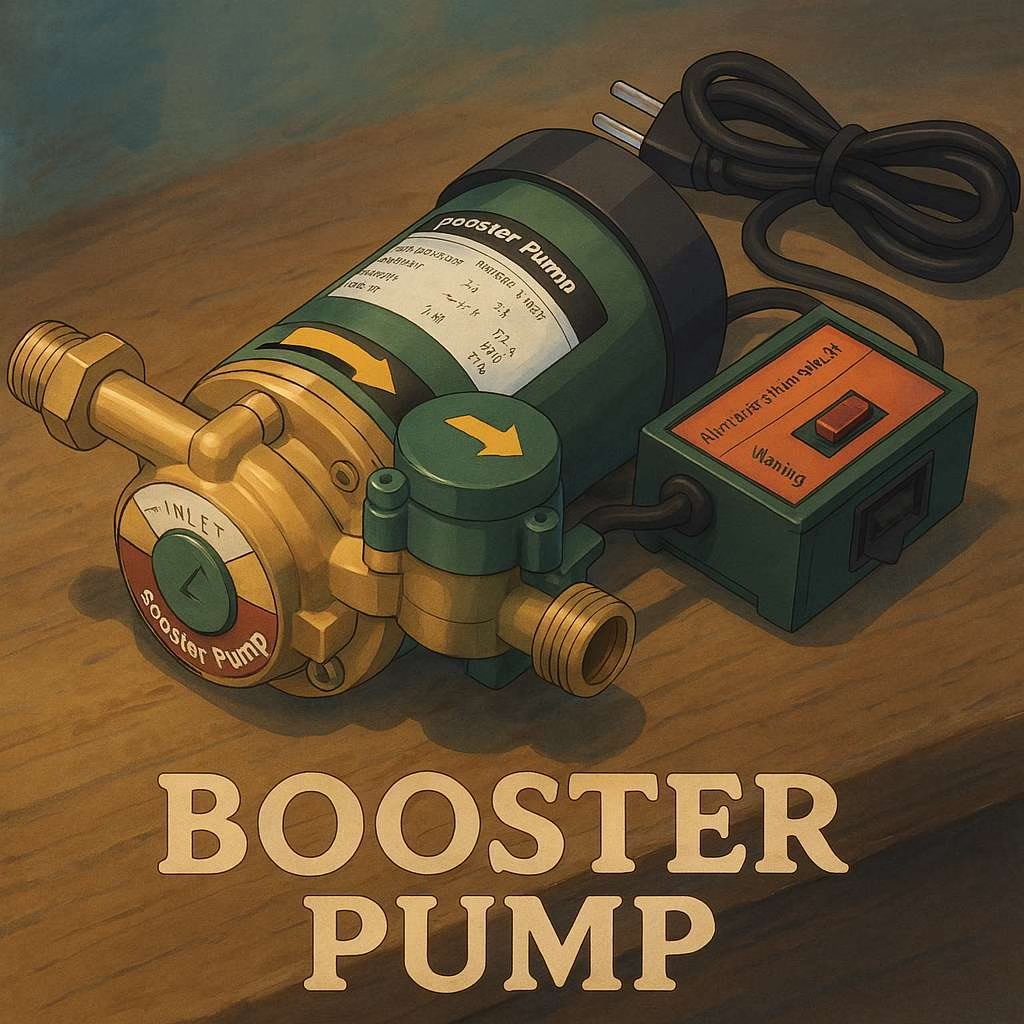
Are you facing a low water pressure problem?
From small gardens to big farms faced with the problem of water pressure issues is common.
Especially if the water source is far away or the field or structure is big, delivering water quickly becomes a problem as irrigation systems like sprinklers and mist require high water pressure.
To tackle the issue Booster pumps are introduced. These specialized pumps help overcome pressure drops and distance limitations, making them essential for efficient irrigation.
In this post, we’ll dive deep into booster pumps—their types, applications in irrigation, selection criteria, and maintenance needs.
What Is a Booster Pump?
As the name Booster pump is, the pump increases the water pressure.
A booster pump does not lift the water, instead, it is installed within the irrigation system to boost the water that’s already flowing through the system.
To boost the water Booster pumps use many techniques, based on those techniques Booster pumps are divided into many types.
Types of Booster Pumps
Centrifugal Pumps
A centrifugal pump uses centrifugal force to move water through the impeller, and there are many types of centrifugal pumps.
End Suction Centrifugal Pump (Single Stage)
Single stage pumps have the suction inlet at the end of the pump and the discharge outlet at the top.
Vertical Multistage Centrifugal Pump
Three types of pumps have multiple impellers having a vertical design. They are often used in spaces where horizontal space is limited.
Multistage Centrifugal Pump
Contain multiple impellers stacked to create more pressure, making them the best choice for large buildings, and industrial purposes.
Characteristics:
- High flow rates
- Moderate pressure capabilities
- Cost-effective
- Relatively simple design
Jet Booster Pump
A jet booster pump is similar to a centrifugal pump with a venturi system to create suction.
Single-Jet Pumps: Suitable for shallow water sources (up to 25 feet)
Convertible Jet Pumps: Can be configured for either shallow or deep well applications
Deep-Well Jet Pumps: Designed for depths of 25-120 feet
Characteristics:
- Good for shallow wells and irrigation systems with variable water sources
- Self-priming capabilities
- Lower maintenance requirements
- Moderate efficiency
Turbine Booster Pump
This booster pump impeller has multiple small channels and is designed for high-volume, high-lift applications.
Common Uses:
- Large agricultural operations
- Golf courses
- Municipal irrigation systems
Characteristics:
- Excellent for high-pressure requirements
- High efficiency at consistent flow rates
- Suitable for deep wells and large irrigation projects
- Multiple staging capabilities for extreme pressure needs.
Submersible Booster Pump
These pumps are designed to be placed directly in the water source. You can think of this as the regular submersible pump but booster submersible pumps used in small operations like:
- Deep well irrigation systems
- Pond or lake-based irrigation
- Rainwater harvesting systems
Characteristics:
- Excellent for deep water sources
- Very efficient operation
- Quiet performance (since they operate underwater)
- No priming required
Positive Displacement Booster Pump
These pumps trap a fixed amount of liquid within their chamber and forcefully displace it to the discharge side, delivering a consistent flow rate regardless of pressure changes.
Types:
Rotary Pumps: Use rotating components to move water
Reciprocating Pumps: Use pistons or diaphragms to move water in a back-and-forth motion
Peristaltic Pumps: Use rollers to compress a flexible tube to move water
Characteristics:
- Consistent flow, regardless of pressure changes
- Excellent for applications requiring precise water delivery
- Higher maintenance requirements
- Generally more expensive than centrifugal options
Variable Speed Booster Pump Systems
Variable Speed Booster Pump uses the variable speed drive technology to adjust the motor speed to match the demand.
Characteristics:
- Adjust pump speed based on actual system demand
- Energy efficient
- Provide consistent pressure regardless of flow requirements
- Reduce water hammer and pressure surges
Benefits:
- Significant energy savings (up to 50%)
- Extended equipment life
- Precise pressure control for different irrigation zones
Ok, these are the types of booster pumps. Now look at some best booster pumps available on the market.
List of Irrigation Booster Pumps
KolerFlo Booster Pump
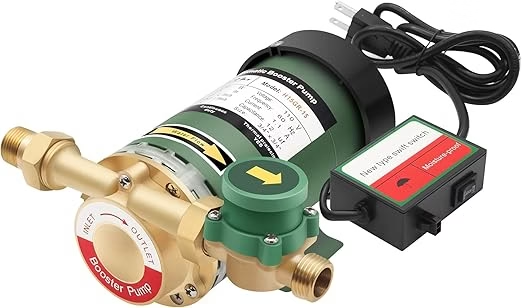
This China-based 120W water booster pump gives you 21.7 PSI pressure.
And can give you a 25 ltr per minute flow rate. The water boost pump has a flow switch that can automatically adjust to your needs, Increase the pressure of the household water tank, and keep a steady pressure.
Comes with a copper pump head, which is durable, no matter how long you use it. And the Smart Control Box turns on the pump when you need to and shuts it off when you close the faucet.
Easy to install, only need a wrench to connect the pump, saving you the cost of plumbers. The pump is also energy-saving; Easy to Operate, and Silence Working.
Dreyoo Water Pressure Booster Pump
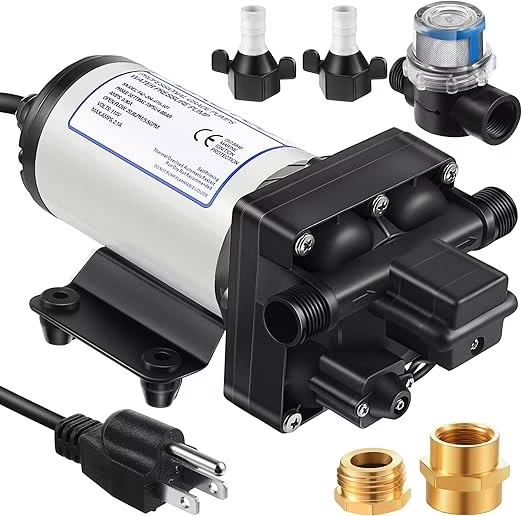
Compared to Kolor Flo, Dreyoo slightly gives you a better PSI of 70 with 5.5 gallons output.
110v AC CE certified and has an automatic pressure switch that turns it on immediately when the faucet is on. Equipped with industry-standard fittings, power plug, and galvanized anti-rust mounting base to directly replace similar common water pressure pumps.
Along with the pump, you’ll get 1 x 1/2 inch twist-on water strainer (includes 50 mesh stainless steel screen), 2 x hose fittings, 2 x brass fittings, 1 x user manual, and 1 x box container.
VIVOSUN Water Pressure Pump
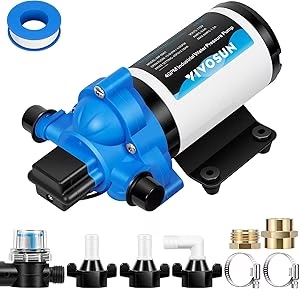
Vivosun is a pure copper motor, with low power consumption and stability, having rubber feet to reduce the noise.
Operates in 115VAC with the water pressure of 4 GPM and 45 PSI.
To reduce the vibration, the pump is equipped with a galvanized iron mounting bracket that you can secure with screws; The pump also comes with a built-in adjustable pressure switch that automatically turns off the machine when it exceeds 45 PSI and rubber feet to reduce noise.
Pump comes with a strainer to filter the water and 3 chambers designed to push the water supporting the 3 to 5 faucets at a time.
SEAFLO 33-Series Water Pressure Pump
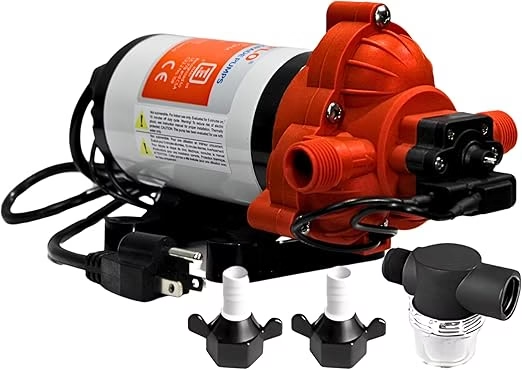
Seaflo is a popular water pressure 115v pump.
The pump has 3.3 GPM and 45 PSI pressure.
Seaflo built with high-quality Santoprene and EPDM, this pump offers excellent resistance to abrasion and corrosion, making it ideal for both freshwater and saltwater environments.
The pumps feature a robust three-chamber diaphragm capable of delivering a reliable flow rate of 3.3 GPM. This design supports up to 3-4 fixtures simultaneously.
For added convenience, this pump includes a plug for a standard wall outlet, simplifying setup and making it easy to integrate into any water system, whether on the road, at home, or out on the water.
ZYIY Water Pressure Booster Pump
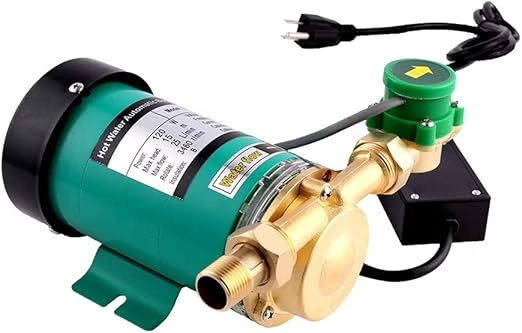
This 120W pump is quite a powerful pump.
Generating 7 GPM with a switch can automatically adjust to your needs, increase the pressure of the household water tank, and keep a steady pressure, energy saving, and no leakage.
The best feature is that it can suck tap water from one or two floors below directly, so it completely solves the problem that the higher floors do not have water while the lower floors have.
The whole pump is sealed well, and the conveyed water will be sanitary.
The automatic switch adopts electronics theory for controlled by water current.
How Booster Pump Support Irrigation
Booster pumps have multiple benefits to the irrigation system making them one of the key parts in modern irrigation practices.
Overcome Geographical Challenges
Not all the terrain is plain and simple for optimum irrigation, especially in the hill sections it is difficult to supply enough water.
Booster pumps ensure that water reaches every part of the field with sufficient pressure, regardless of elevation differences.
For example, in hillside vineyards or terraced farming, booster pumps maintain consistent water delivery across different elevation zones. Without them, higher areas would receive insufficient water while lower areas might get oversaturated.
Extend irrigation Range
For large land, it is always challenging to cover one irrigation system, so booster pumps come to help.
As water travels through irrigation pipes, pressure naturally decreases due to friction and distance. Booster pumps installed at strategic intervals maintain adequate pressure throughout the entire system.
This capability allows it to irrigate far-reaching fields without installing multiple primary pumping stations, significantly reducing infrastructure costs.
Supporting Advanced Irrigation Technologies
New and advanced irrigation systems with improved materials like drip irrigation, micro-sprinklers, and pivot systems require specific pressure parameters to function correctly.
Booster pumps ensure these irrigation methods operate to their optimum by maintaining pressure range, maximizing water use efficiency and crop yields.
Maintain Water Source Flexibility
All the irrigation systems not depend on the same water source, each with different natural pressure characteristics:
- Municipal water supplies (typically high pressure)
- Wells (variable pressure based on depth and aquifer conditions)
- Surface water (lakes, ponds, rivers with low natural pressure)
- Rainwater collection systems (minimal natural pressure)
Booster pumps standardize pressure from these diverse sources, allowing irrigation systems to function consistently regardless of the water origin.
Improve Energy Efficiency
While pumps consume energy, strategically deployed booster pumps can actually improve the overall energy efficiency of irrigation systems by:
- Reducing the workload on primary pumps
- Enabling the use of smaller diameter pipes (which are less expensive)
- Supporting precise irrigation scheduling
- Minimizing water waste through even distribution
Last Words…
Booster pumps are a core component of modern irrigation systems.
When selecting a pump, consider factors like:
- Flow Rate Requirements
- Pressure Requirements
- Power Source Considerations
- Installation Environment
- System Integration
You can make informed decisions that optimize water use, reduce energy consumption, and ultimately improve crop yields.
As water conservation becomes increasingly critical in agriculture, the role of properly selected and maintained booster pumps will only grow in importance.
With advances in smart technology and energy efficiency, these systems will continue to evolve, offering even greater benefits to sustainable farming practices.

Leave a Reply